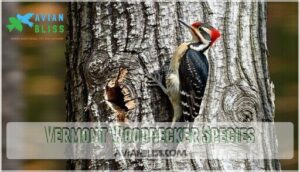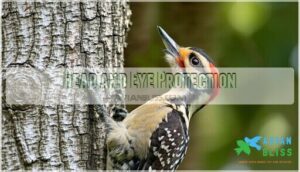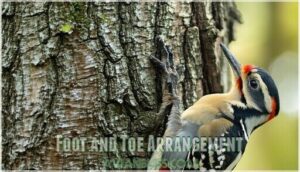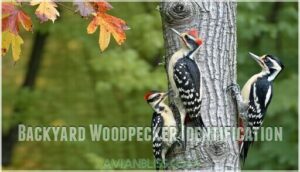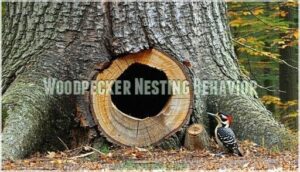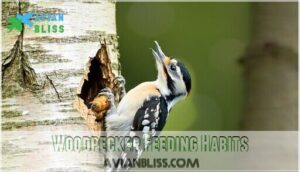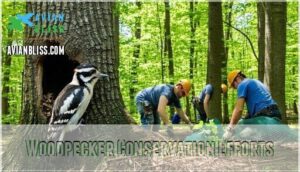This site is supported by our readers. We may earn a commission, at no cost to you, if you purchase through links.
 You’ll find ten distinct woodpeckers in Vermont, from the crow-sized Pileated Woodpecker to the sparrow-sized Downy.
You’ll find ten distinct woodpeckers in Vermont, from the crow-sized Pileated Woodpecker to the sparrow-sized Downy.
These remarkable birds have evolved incredible adaptations that’ll blow your mind – their beaks actually regenerate at the tips to stay razor-sharp, while spongy skull structures prevent brain damage from constant hammering.
Vermont’s mixed forests provide perfect habitat for these specialized drummers, whether you’re hearing them in your backyard or deep in state parks.
The Pileated sports a brilliant red crest, while Downy and Hairy Woodpeckers frequent suet feeders.
Their zygodactyl feet can rotate toes for impossible gripping angles, making them nature’s ultimate tree-climbing specialists.
Table Of Contents
- Key Takeaways
- Vermont Woodpecker Species
- Woodpecker Beak Adaptations
- Head and Eye Protection
- Foot and Toe Arrangement
- Backyard Woodpecker Identification
- Woodpecker Nesting Behavior
- Woodpecker Feeding Habits
- Woodpecker Damage Prevention
- Woodpecker Conservation Efforts
- Woodpecker Watching in Vermont
- Frequently Asked Questions (FAQs)
- What kind of woodpeckers live in Vermont?
- How to tell the difference between a Downy Woodpecker and a hairy woodpecker?
- Is it good to have woodpeckers in your yard?
- What is the most common woodpecker in New England?
- Why are woodpeckers pecking my house?
- How do you tell the difference between a Downy Woodpecker and a hairy woodpecker?
- What does it mean when you see a woodpecker?
- How do woodpeckers find sufficient food sources?
- What are woodpeckers natural predators in Vermont?
- How long is the typical lifespan?
- Conclusion
Key Takeaways
- You’ll find ten distinct woodpecker species in Vermont, from the massive crow-sized Pileated Woodpecker with its brilliant red crest to the tiny sparrow-sized Downy Woodpecker that frequents backyard suet feeders.
- You can identify these birds by their incredible adaptations – they’ve got chisel-like beaks that regenerate at the tips, spongy skull structures that prevent brain damage from constant hammering, and zygodactyl feet with rotating toes for superior tree-gripping power.
- You’ll spot the most common backyard visitors by size and markings: Downy Woodpeckers are sparrow-sized with white-spotted black wings, Hairy Woodpeckers are robin-sized with solid black upperparts, and Pileated Woodpeckers are crow-sized giants with flaming red crests.
- You can protect your property from woodpecker damage using visual deterrents like reflective tape, habitat modification by removing dead branches that attract insects, and physical barriers like hardware cloth or metal flashing on vulnerable wooden structures.
Vermont Woodpecker Species
In Vermont’s diverse forests, you’ll discover ten woodpecker species with distinct characteristics.
Common species like the Downy Woodpecker and Hairy Woodpecker thrive year-round in woodlands and suburban areas.
The massive Pileated Woodpecker, crow-sized with its flaming red crest, creates distinctive oblong cavities.
Rare woodpeckers include the Red-bellied, increasingly found in Lake Champlain Valley.
Each species shows unique habitat preferences and seasonal activity patterns for species identification.
You can learn more about the Vermont’s woodpecker diversity from online resources.
Woodpecker Beak Adaptations
You’ll discover that woodpecker beaks function as precision tools designed for specific tasks, with chisel-like tips that withstand incredible force while drilling into bark and wood.
Nature’s power tools: woodpecker beaks deliver over 1,000 times the force of gravity without breaking.
These specialized beaks constantly regenerate their cells to prevent wear, allowing Vermont’s woodpeckers to strike with over 1,000 times the force of gravity without damage.
Chisel-like Beaks
You’ll notice Vermont woodpeckers sport specialized chisel beaks that pack serious drilling force.
Their unique beak composition features a three-layer structure: hard keratin exterior, foam middle, and mineral-rich inner core.
This design lets species like Downy and Pileated woodpeckers master excavation techniques, hammering tree bark 20 times per second without beak wear affecting their woodpecker anatomy.
Their unique skull structure serves as a natural model for studying head impact dynamics.
Beak Tip Regeneration
Beyond their chisel design, Vermont woodpeckers showcase remarkable beak maintenance through continuous cellular regeneration.
The beak wear rate stays minimal because new cells constantly replace worn tips.
This regeneration speed varies among woodpecker species based on diet influence and genetic factors.
Like parrots, woodpeckers benefit from natural beak cleaning behaviors to maintain beak health.
Whether you’re watching downy or pileated woodpeckers, their cellular mechanisms guarantee these chisel beaks remain sharp for life.
- Cells regenerate faster than beak wear occurs in active foraging
- Regeneration speed differs between woodpecker species and their diets
- Cellular mechanisms work continuously without seasonal breaks or pauses
- Diet influence affects how quickly new beak material forms
- Genetic factors determine each Vermont woodpecker’s regeneration efficiency
Uneven Beak Halves
Woodpecker beaks aren’t perfectly symmetrical – they’re intentionally uneven. This beak asymmetry creates an evolutionary advantage by distributing impact forces across different areas during pecking.
The elongated lower beak works with specialized foraging techniques to reduce skull stress. This woodpecker biomechanics marvel prevents beak wear while protecting the brain from repeated impacts.
| Beak Feature | Impact Distribution | Protection Benefit |
|---|---|---|
| Lower Elongation | Spreads force vertically | Reduces skull pressure |
| Asymmetrical Design | Disperses shock waves | Prevents brain injury |
The combination of these features results in a highly effective system for withstanding the rigors of pecking, making woodpeckers a fascinating example of adaptation in nature.
Head and Eye Protection
When you watch a woodpecker hammer its beak against a tree trunk at 20 times per second, you’re witnessing one of nature’s most remarkable shock-absorption systems in action.
Witnessing nature’s precision engineering as a woodpecker transforms into a living jackhammer, defying physics with every thunderous strike.
These birds have evolved specialized skull structures, including a unique hyoid bone that wraps around their brain and a protective third eyelid, to prevent brain damage and eye injuries during their relentless pecking, which is a testament to their highly adapted nature.
Hyoid Bone
Beyond a woodpecker’s specialized beak, you’ll find nature’s most ingenious safety system: the hyoid bone.
This remarkable structure wraps around the skull like a protective helmet, anchoring the tongue while distributing impact forces away from the brain.
- Hyoid Function: Acts as a shock-absorbing safety belt during high-impact pecking
- Tongue Support: Anchors the long tongue that extends deep into tree crevices
- Bone Structure: Wraps completely around the skull for maximum protection
- Muscle Attachment: Connects to powerful neck muscles that control pecking force
Spongy Structures
The incredible cranial sponginess found in woodpecker skulls acts like nature’s built-in shock absorbers.
These specialized bone structures provide essential brain protection during high-impact pecking sessions.
Vermont birds have evolved remarkable impact resistance features that distribute forces throughout their skulls.
- Shock Absorption: Spongy bone layers cushion repeated impacts
- Force Distribution: Spreads energy across skull surface areas
- Brain Protection: Prevents concussions during intense drilling sessions
Nictitating Membrane
Think of the nictitating membrane as nature’s built-in safety glasses.
This transparent third eyelid snaps shut milliseconds before impact, protecting woodpecker eyes from flying debris.
All Vermont woodpecker species share this protection mechanism – an evolutionary advantage that keeps their vision sharp.
The membrane’s transparency level allows continued sight while providing complete coverage during drilling operations.
Foot and Toe Arrangement
You’ll notice that Vermont’s woodpeckers have a unique foot structure called zygodactyl feet, where two toes point forward and two point backward.
This arrangement gives them a powerful grip on tree bark, and they can rotate their outer toe to switch between climbing positions for maximum stability.
Zygodactyl Feet
Vermont’s woodpecker species showcase remarkable toe arrangement that sets them apart from most birds.
You’ll notice their zygodactyl feet feature two toes pointing forward and two backward, creating superior grip strength on vertical surfaces.
This climbing adaptation gives woodpeckers a significant evolutionary advantage over birds with traditional toe layouts.
Key benefits of zygodactyl feet include:
- Enhanced perching stability on smooth bark surfaces where other birds struggle
- Maximum contact points with tree trunks during vertical climbing movements
- Secure anchoring while hammering into wood for food or nesting cavities
These bird adaptations make woodpecker characteristics perfectly suited for their arboreal lifestyle.
Rotating Toes
Beyond their zygodactyl arrangement, these birds showcase remarkable toe flexibility.
You’ll notice how woodpecker species can rotate their backward-facing toes sideways, dramatically boosting grip strength on Vermont’s maple and birch trees.
This evolutionary advantage transforms ordinary climbing adaptations into precision tools for woodpecker behavior.
Watch closely during Vermont birdwatching sessions—you’ll see how rotating toes create rock-solid perch stability on vertical surfaces.
Whether they’re hammering for insects or scanning woodpecker habitats, this flexibility lets them pivot without losing their hold.
Woodpecker identification becomes easier when you understand these incredible anchoring systems that make tree-climbing look effortless.
Backyard Woodpecker Identification
You’ll encounter three main woodpecker species in your Vermont backyard: the crow-sized Pileated Woodpecker with its striking red crest, the sparrow-sized Downy Woodpecker with white spots on black wings, and the robin-sized Hairy Woodpecker with solid black upperparts.
Learning to distinguish these common visitors by size, markings, and behavior will help you identify which species are visiting your feeders and trees, allowing for a better understanding of the woodpecker species.
Pileated Woodpecker
You’ll easily spot this crow-sized giant by its blazing red crest and powerful drumming that echoes through Vermont’s forests.
Here’s what makes Pileated Woodpeckers special:
- Pileated Diet: They feast on carpenter ants and wood-boring beetles hidden deep in dead trees
- Habitat Needs: Mature forests with large standing dead trees provide ideal nesting sites
- Identification Tips: Look for distinctive rectangular excavation holes and undulating flight patterns.
They are non-migratory, remaining in year-round territories.
Downy Woodpecker
As Vermont’s tiniest woodpecker, the Downy Woodpecker brings charm to your backyard birdwatching adventures.
These pint-sized performers frequent Downy Habitat like deciduous forests, parks, and suburban yards.
Their Downy Diet includes insects, seeds, and suet from feeders.
Listen for their soft "pik" Downy Sounds and gentle drumming.
Downy Behavior involves acrobatic feeding on small branches.
Watch for Downy Lookalikes – they’re smaller than Hairy Woodpeckers with proportionally shorter bills, making Vermont bird species identification easier.
Hairy Woodpecker
When you spot a Hairy Woodpecker in Vermont’s forests, you’ll notice its robin-sized frame and sturdy beak that’s perfect for drilling into bark. These black-and-white beauties are year-round residents that’ll make your birdwatching adventures more exciting.
Here are 5 key identification features:
- Size matters – Larger than Downy Woodpeckers at 7-10 inches long
- Beak basics – Long, chisel-like bill equals body length from head to beak tip
- Color patterns – Males sport red patches on their heads; females don’t
- Hairy Habitat – Prefers mature woodlands and recently burned forests
- Hairy Sounds – Sharp "peek" calls and rapid drumming sequences
The Hairy Diet consists mainly of wood-boring insects and larvae found beneath tree bark. Unlike their Hairy Lookalikes (Downy Woodpeckers), these woodpeckers tackle larger prey with their powerful beaks. Hairy Threats include habitat loss and climate change affecting Vermont bird species.
For successful birdwatching Vermont adventures, listen for their distinctive Hairy Sounds echoing through woodpecker habitats in Vermont. You’ll often find them working methodically up tree trunks, their systematic approach making them easier to track than other species.
Woodpecker Nesting Behavior
Most woodpecker nesting begins with cavity nesting in dead trees or soft wood branches. Both parents excavate these homes over 2-3 weeks.
The clutch size typically ranges from 3-5 white eggs, with a 12-14 day incubation period. Parents share duties equally during this time.
Nest materials are minimal—just wood chips line the bottom. Excellent parental care includes removing waste to maintain sanitation throughout the woodpecker breeding season.
| Breeding Stage | Duration | Parent Responsibility |
|---|---|---|
| Cavity Excavation | 2-3 weeks | Both parents drill |
| Egg Laying | 3-5 days | Female lays clutch |
| Incubation | 12-14 days | Shared duty rotation |
| Nestling Care | 24-28 days | Both feed young |
| Fledgling Support | 2-3 weeks | Continued feeding |
Woodpecker Feeding Habits
You’ll discover that Vermont’s woodpeckers use specialized feeding techniques to extract wood-boring insects and tree sap from bark.
These birds have developed unique feeding behaviors that help them access protein-rich insects and sweet sap throughout Vermont’s forests.
Wood-boring Insects
Wood-boring insects serve as protein-packed meals for Vermont’s woodpeckers.
These birds excel at insect identification, targeting larvae and adults hiding beneath bark.
Their woodpecker diet relies heavily on finding these creatures in decaying wood, where insect habitats flourish.
You’ll notice how their specialized beaks help with natural pest control, reducing wood damage from harmful insects.
Larval stages woodpeckers commonly hunt include:
- Beetle grubs: Fat, white larvae tunneling through dead wood, creating distinctive galleries
- Carpenter ant colonies: Social insects hollowing out soft wood for their underground cities
- Wood wasp larvae: Cylindrical insects boring deep holes, weakening tree structure
This feeding behavior benefits both forests and woodpecker habitat management.
Tree Sap
Beyond hunting insects, Vermont’s woodpeckers have developed a sweet tooth for tree sap.
The Yellow-bellied Sapsucker leads this Sap Harvesting behavior, drilling neat rows of holes called Tree Wounds to access the sugary fluid.
This Sapsucker Diet provides essential energy when insects are scarce. Sap Composition offers carbohydrates and minerals that satisfy Woodpecker Thirst during migration periods.
Vermont’s woodpecker diet diversity keeps these birds thriving year-round, as documented in the Vermont bird atlas and Vermont wildlife studies.
| Sap Source | Sugar Content | Peak Season | Primary User | Collection Method |
|---|---|---|---|---|
| Maple Trees | 2-4% | Early Spring | Yellow-bellied Sapsucker | Horizontal drill holes |
| Birch Trees | 1-2% | Late Winter | Multiple species | Vertical tap holes |
| Apple Trees | 3-5% | Spring | Red-bellied Woodpecker | Scattered holes |
| Oak Trees | 1-3% | Summer | Downy Woodpecker | Deep bore holes |
| Pine Trees | 0.5-1% | Year-round | Hairy Woodpecker | Resin wells |
Woodpecker Damage Prevention
You can protect your property from woodpecker damage using simple methods that won’t harm these important birds.
Effective strategies include installing visual deterrents like reflective tape, modifying your yard’s habitat, and placing protective barriers on vulnerable wooden structures.
Visual Deterrents
Reflective surfaces like bird tape and mirrors create flashing lights that startle woodpeckers away from your property.
Predator decoys such as fake owls or hawks tap into their natural fear responses.
Scare balloons with large eye patterns and pinwheels that spin in the breeze add movement that makes woodpeckers uncomfortable, protecting Vermont wildlife habitats while preserving your home’s exterior.
Many homeowners purchase specialized bird tape for this purpose.
Habitat Modification
Smart property management can reduce woodpecker damage through targeted habitat modification. Remove dead branches that attract insects, since healthy trees discourage foraging.
Address invasive species and forest fragmentation around your property. Plant native vegetation to support bird habitats in Vermont while directing woodpeckers away from structures.
You can also explore woodpecker deterrent products to further protect your property. These habitat restoration efforts combat urbanization impact and climate change effects on woodpecker habitats preservation in Vermont.
Barriers
Physical barriers offer your best defense when habitat modification isn’t enough to deter persistent woodpeckers from damaging your property.
- Hardware cloth or mesh netting: Wrap around vulnerable wooden structures like siding, trim, or deck railings
- Metal flashing strips: Install over favorite drumming spots on gutters, chimneys, or roof edges
- Plastic sheeting: Provide temporary protection during peak activity seasons
- Steel wool or caulk: Fill existing holes to prevent further excavation
- Sound-dampening foam: Reduce drumming echoes that attract territorial disputes
To maximize effectiveness, consider strategic placement of these deterrents.
Woodpecker Conservation Efforts
Protecting woodpeckers in Vermont requires dedicated conservation efforts that you can support.
Vermont bird diversity depends on coordinated strategies that address modern challenges.
Woodpecker conservation in Vermont focuses on three key approaches:
- Habitat Preservation – Maintaining old-growth forests and dead trees
- Forest Management – Using sustainable logging practices that protect nesting sites
- Population Monitoring – Tracking species through citizen science programs
Public Awareness campaigns help residents understand these birds’ ecological importance.
Climate Change threatens traditional habitats, making bird conservation efforts in Vermont increasingly essential for woodpecker survival.
Woodpecker Watching in Vermont
Throughout Vermont’s seasons, woodpecker watching offers year-round birdwatching adventures.
You’ll spot these fascinating birds in backyard feeders, state parks, and mature forests.
Bring binoculars and field guides for ideal identification.
Respect nesting sites and maintain quiet distances during breeding season.
Join citizen science projects like eBird to contribute valuable data about Vermont’s woodpecker populations.
| Location Type | Best Species | Prime Seasons |
|---|---|---|
| Backyard Feeders | Downy, Hairy | Year-round |
| State Parks | Northern Flicker, Red-bellied | Spring, Summer |
| Mature Forests | Pileated, Yellow-bellied Sapsucker | All seasons |
| Burned Areas | Black-backed, Three-toed | Winter, Early Spring |
Frequently Asked Questions (FAQs)
What kind of woodpeckers live in Vermont?
Like nature’s carpenters wielding tiny hammers, you’ll discover ten woodpecker species calling Vermont home.
You’ll commonly spot Downy, Hairy, Northern Flicker, Pileated, and Yellow-bellied Sapsuckers year-round, while rarer species occasionally visit your backyard.
How to tell the difference between a Downy Woodpecker and a hairy woodpecker?
You’ll spot the key difference in size – Hairy Woodpeckers are markedly larger at 9-11 inches versus Downy’s 5-7 inches.
Hairy’s also have longer, chisel-like beaks compared to Downy’s shorter, stubby bills, which is a key difference.
Is it good to have woodpeckers in your yard?
Woodpeckers are nature’s pest control squad, gobbling up insects that damage your trees and garden.
You’ll love watching their acrobatic antics while they keep harmful bugs at bay naturally and free.
What is the most common woodpecker in New England?
You’ll find the Downy Woodpecker is New England’s most common species. This small, black-and-white bird with its distinctive red cap frequents backyards, parks, and forests year-round throughout the region.
Why are woodpeckers pecking my house?
Your house offers prime real estate for woodpeckers seeking insects, drumming territories, or nesting sites.
They’re attracted to wood siding, cedar shakes, or eaves with carpenter ants, termites, or suitable cavities for shelter.
How do you tell the difference between a Downy Woodpecker and a hairy woodpecker?
Check the beak length first – Hairy Woodpeckers have longer, chisel-like beaks while Downy Woodpeckers sport shorter bills.
You’ll also notice Hairy Woodpeckers are larger overall, measuring 9-11 inches compared to Downy’s 5-7 inches, which can be a clear distinction, and their size is a key factor, making them larger.
What does it mean when you see a woodpecker?
Seeing a woodpecker typically signals healthy forest ecosystems, as these birds indicate abundant insect populations and mature trees.
You’re witnessing nature’s pest control at work—they’re simply hunting for food, not delivering mystical messages.
How do woodpeckers find sufficient food sources?
You’ll notice woodpeckers use their keen hearing to detect insects moving beneath bark.
They’ll tap systematically, listening for hollow sounds that reveal grub tunnels, then drill precisely to access their protein-rich meals.
What are woodpeckers natural predators in Vermont?
You’ll find hawks, owls, foxes, raccoons, and snakes pose threats to Vermont’s woodpeckers.
Squirrels steal eggs while cats hunt adults.
These birds face dangers from above, below, and climbing predators throughout their forest homes.
How long is the typical lifespan?
You’ll observe woodpecker lifespans varying by species – smaller ones like Downys typically live 4-6 years.
While larger species such as Pileateds can reach 12-15 years in wild conditions with ideal habitat.
Conclusion
Every spring morning, millions of hammer strikes echo through Vermont’s forests as these feathered carpenters begin their daily work.
Now you’re equipped to identify woodpeckers in Vermont and appreciate their remarkable adaptations.
From the Pileated’s booming calls to the Downy’s gentle tapping at your suet feeder, each species plays a pivotal role in forest health.
Grab your binoculars, step outside, and discover these incredible birds that turn Vermont’s trees into nature’s percussion section.

